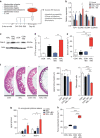Diet and specific microbial exposure trigger features of environmental enteropathy in a novel murine model
- PMID: 26241678
- PMCID: PMC4532793
- DOI: 10.1038/ncomms8806
Diet and specific microbial exposure trigger features of environmental enteropathy in a novel murine model
Abstract
Environmental enteropathy (EE) is a subclinical chronic inflammatory disease of the small intestine and has a profound impact on the persistence of childhood malnutrition worldwide. However, the aetiology of the disease remains unknown and no animal model exists to date, the creation of which would aid in understanding this complex disease. Here we demonstrate that early-life consumption of a moderately malnourished diet, in combination with iterative oral exposure to commensal Bacteroidales species and Escherichia coli, remodels the murine small intestine to resemble features of EE observed in humans. We further report the profound changes that malnutrition imparts on the small intestinal microbiota, metabolite and intraepithelial lymphocyte composition, along with the susceptibility to enteric infection. Our findings provide evidence indicating that both diet and microbes combine to contribute to the aetiology of EE, and describe a novel murine model that can be used to elucidate the mechanisms behind this understudied disease.
Figures







Comment in
-
Malnutrition: New mouse model of EE.Nat Rev Gastroenterol Hepatol. 2015 Sep;12(9):489. doi: 10.1038/nrgastro.2015.144. Epub 2015 Aug 18. Nat Rev Gastroenterol Hepatol. 2015. PMID: 26284563 No abstract available.
References
Publication types
MeSH terms
Associated data
Grants and funding
LinkOut - more resources
Full Text Sources
Other Literature Sources
Medical

